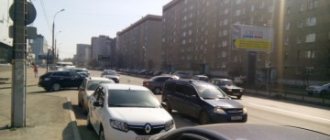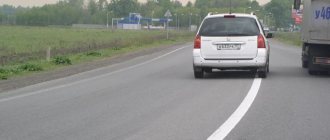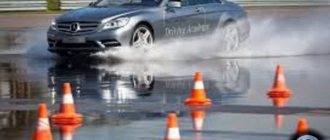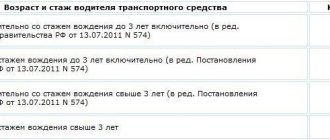The main types of punishment for a “No overtaking” sign
Overtaking in the area covered by the sign can be safe, but often this kind of maneuver in prohibited places is accompanied by great public danger. Authorized employees, after assessing the traffic situation, will hold the motorist accountable according to the following system:
- overtaking in the presence of a prohibitory sign - 5 thousand rubles;
- repeated overtaking in the wrong place - confiscation of the license for 12 months;
- if a violation is recorded by an automatic camera - 5 thousand rubles;
- if a violation is repeatedly recorded using video equipment - 5 thousand rubles.
- making a U-turn or turning left on a section of road that prohibits such maneuvers - 1.5 thousand rubles;
- avoiding obstacles in the sign's coverage area - 1.5 thousand rubles;
- the driver overtook using the side of the road - 1.5 thousand rubles;
- overtaking on a section of the road that is not equipped with markings, but has a prohibitory sign - 500 rubles;
It can be noted that even if a repeated violation is detected automatically, the driver does not risk losing his driver’s license. This is the peculiarity of recording violations using cameras.
Definition of overtaking in 2021
According to the legislation in force for 2021, overtaking is only considered to be ahead of a passing vehicle, accompanied by driving into the lane of oncoming traffic. This concept should not be confused with ahead or detour. Unfortunately, in the traffic rules, the analysis of each definition is presented very vaguely, which raises many questions in controversial situations.
Overtaking is the act of avoiding a car ahead using a lane of passing traffic. The difference in the concepts of “ahead” and “overtaking” is only that when overtaking, the driver uses the oncoming lane. Detour is the process of overcoming a stationary obstacle located on the road.
○ What is overtaking?
Many drivers initially confuse overtaking and ahead. In fact, overtaking is just one of its types. The concept of overtaking is contained in paragraph 1.2 of the traffic rules:
- “Overtaking” is the advance of one or more vehicles, associated with entering the lane of oncoming traffic, and subsequent return to the previously occupied lane.”
The maneuver will be considered overtaking only if the car enters the oncoming lane and then returns to its own; it is performed with the aim of getting ahead of another vehicle. In this case, the speed of the overtaking vehicle will be greater than the one being overtaken.
Overtaking is not prohibited by law unless it is done in violation of established rules.
In what cases is overtaking prohibited 2021
A sign prohibiting overtaking maneuver is usually installed outside the city. On a suburban highway, the owner of a vehicle may receive a serious fine when overtaking in the coverage area of sign 3.20 (“Overtaking is prohibited”).
On highways with high speed limits, the likelihood of an accident occurring when overtaking with the help of oncoming traffic increases significantly. When overtaking at high speeds, there is a high probability of death in the event of an accident. For this reason, the authorities are trying to strictly control cases of illegal entry into the oncoming lane in the area covered by sign 3.20.
Outside the city, traffic officers often set up various “traps” and “ambushes” to catch offenders. For this kind of disregard for traffic rules, the driver may well lose his driver's license.
If a motorist has entered the coverage area of sign 3.20, he must remain in the lane of passing traffic. The restriction will be lifted only when the overtaking prohibition sign expires, which can begin in several cases:
- The driver has already covered the distance indicated on the sign (overtaking is prohibited only for the indicated duration of the road);
- The motorist crossed a sign stating that sign 3.20 has been cancelled;
- The owner of the vehicle has reached a populated area;
- The driver has crossed a sign canceling all possible restrictions (3.31);
- The motorist reached the intersection and drove through it.
It is worth noting that on intercity highways, signs prohibiting overtaking are installed in places with high accident rates. Thus, overtaking is prohibited at the end of slopes, at the beginning of sharp turns and in areas with limited visibility.
Places where overtaking can be dangerous.
It’s not for nothing that in some places the rules prohibit overtaking, since they are very high-risk. Let's look at the list of places where it is better to completely forget about overtaking, so as not to provoke an emergency situation, the consequence of which will be deprivation of the right to drive a car or a fine, or even serious physical injury or death.
An intersection with traffic lights and similar means of regulation.
Overtaking maneuvers are not permitted at all controlled intersections. And while a motorist is driving on a secondary road.
A motorist can overtake at an uncontrolled intersection if he is driving on a primary road.
Any pedestrian crossing.
Since 2014, overtaking has been completely prohibited on the section of the road designated as a pedestrian crossing, due to the high risk of not seeing a pedestrian behind a neighboring car. Unfortunately, some drivers ignore this rule and hit pedestrians, mostly at unregulated pedestrian crossings.
Railroad crossing.
Approaching a railway crossing one hundred meters away is always warned by signs 1.1 (rails are shown in a red triangle), 1.2 (a steam locomotive is shown in a red triangle), 1.4.2, 1.4.5 (two red stripes are shown in a rectangle). You need to slow down a little, forgetting about overtaking, until the crossing is behind you.
Bridges, tunnels, overpasses.
Tunnels, overpasses, overpasses and bridges are the most critical places for overtaking; it is there that the consequences of accidents are very severe, even fatal. Despite the fact that some bridges cannot always be noticed in time, drivers who overtake on them are still fined or deprived of their driver's license. The same applies to overtaking in a tunnel and on an overpass. Therefore, before this maneuver you need to be very careful so as not to say goodbye to money or rights, or, in the worst case, to life and health.
Roads with a smaller turning radius, low visibility, end of a steep climb.
Areas with dangerous turns or steep slopes are always marked in advance with warning signs. This is especially true when overtaking on a hill, since it is easy to collide with an oncoming car that appears as if from nowhere. During bad weather or in places with poor visibility, it is better to forget about overtaking altogether, remembering the saying “the slower you go, the further you will go.”
In what cases is overtaking prohibited without a sign 2021
In special areas of vehicle traffic, drivers must be aware of the situation and not allow themselves to make dangerous maneuvers. Thus, overtaking is prohibited in the following areas that are not equipped with the appropriate sign:
- at a controlled intersection;
- at an uncontrolled intersection if the driver is moving on a secondary road;
- at pedestrian crossings where there are less protected road users - pedestrians;
- directly at the railway crossing and closer than a hundred meters in front of it;
- on and under bridges;
- on overpasses;
- on overpasses;
- in the tunnels.
The restrictions on overtaking are in effect due to the increased danger of objects. Thus, at pedestrian crossings, drivers may often not notice those crossing the road. Bridges and overpasses are not always reliable in design and sometimes cannot provide a high level of safety.
It is important to pay attention to other circumstances that prevent safe overtaking. The maneuver is strictly prohibited in the following cases:
- the vehicle in front has not yet completed overtaking;
- the vehicle following the car has begun to overtake;
- The driver in front turned on his turn signal.
Also, overtaking is strictly prohibited if the driver is not convinced that the maneuver being performed is safe.
Traffic rules
To understand the issues of overtaking vehicles at intersections, you should refer to Article 11 (clause 11.4) of the Traffic Regulations. It states that overtaking passing vehicles is prohibited when driving at signalized intersections . You cannot overtake while driving on a secondary road if the intersection is unregulated.
According to traffic rules, you can overtake other cars at an intersection if there is no traffic controller and there is no traffic light, and the driver crosses the intersection on the main road.
Overtaking is called the advance of cars, which is accompanied by the car entering the lane intended for oncoming traffic, and returning to the previous lane after advancing.
If you accidentally cross a solid white line while maneuvering at an intersection, you will not be able to avoid punishment.
If the maneuver is completed without entering the oncoming lane, it is considered ahead and is not considered overtaking. This means that at any intersection with traffic in several lanes of the same direction, you can make an advance, which will end with a return to the previously occupied lane. Of course, this should not violate the queuing conditions for those passing through the intersection.
The rule was recently changed. Now Article 11, paragraph 4 prohibits overtaking if a pedestrian crossing is marked next to the intersection . The ban applies regardless of whether there are pedestrians on the roadway.
How to perform the maneuver correctly?
Overtaking in accordance with traffic rules when passing intersections can only be carried out when the car is driving on the main road. This mainly applies to roads located outside populated areas. Before the intersection you can often find a solid 1.1 marking that cannot be crossed.
The photo shows continuous marking 1.1:
If the driver has been driving recently, he can identify the traffic light signal with the main road - this error occurs frequently. It is worth remembering that there are no secondary roads at signalized intersections .
What should a driver do if the main road changes direction after an intersection? In this case, as defined in Article 13, paragraph 10, motorists must act in accordance with the rules for driving through intersections of roads of equal importance. Overtaking in this case is a prohibited maneuver, and cars leaving from the right will have priority.
When passing through a controlled intersection, you can overtake the vehicle ahead if the following conditions are met:
- The marking line does not prohibit maneuver.
- There are no signs prohibiting overtaking (what is the penalty for overtaking under a sign?).
- Your car is moving along the main road.
When is it allowed and when is it prohibited?
The traffic rules clearly prohibit overtaking on the side of the road in any section of the road (what is the penalty for such a violation?) As for intersections, you cannot overtake cars at regulated and unregulated ones, unless you are driving on the main road (Article 11, paragraph 4). The same clause prohibits overtaking on zebra crossings, railway crossings (and on a 100-meter-long section in front of them), on overpasses, tunnels and bridges (read about the fine for overtaking at a pedestrian crossing here, and on bridges - Here).
Overtaking on the right side is possible if traffic in one direction is organized in several lanes. In this case, it is possible to perform maneuvers from the left lane that involve changing lanes to the right. If a driver is driving on a road with two-way traffic, you cannot drive in the opposite direction after overtaking, if there is a dividing strip, rails or markings 1.1, 1.3. If you make a mistake, you can lose your driver's license. The dangers of crossing a solid line when completing a maneuver are written here, and here you can find out about the sanctions for overtaking through a double solid line.
The photo shows a double continuous marking 1.3:
Who can you overtake in the area of the “No Overtaking” sign?
The legislation provides for the possibility of overtaking certain types of transport in the coverage area of sign 3.20. According to the traffic rules, after passing the “overtaking is prohibited” sign, drivers have the right to get ahead (using the oncoming lane) of the following types of vehicles:
- mopeds;
- motorcycle (without sidecar);
- vehicles equipped with a “slow-moving vehicle” sign;
- horse-drawn carts.
In practice, it is better to refrain from overtaking slow-moving vehicles that are not equipped with the appropriate sign. Even if the vehicle’s speed is less than 30 km/h (which, by definition, qualifies tractors, combines and other equipment as low-speed vehicles), it will be difficult for government officials to prove the legality of their actions.
Regarding mopeds, motorized vehicles and horse-drawn vehicles, the rules remain unchanged. It is better to wait until the end of the prohibited overtaking zone and perform the maneuver in accordance with the traffic rules. However, there are cases when the lifting of the restriction is still far away, but there is no time. In such situations, you can ask the driver of the slow-moving vehicle to pull over to the side of the road using a sound or light signal.
There is an effective way to avoid punishment when overtaking slow-moving vehicles. The motorist must wait until the slow-moving vehicle is overtaken by other road users. Often, traffic police officers stop only the first offenders and ignore subsequent ones.
Where maneuver is allowed
Outside a populated area, a motorist has the right to overtake in the following areas:
- if the roadway consists of two lanes that are separated by dotted markings;
- on a highway with combined marking lines on the asphalt;
- in a three-lane traffic zone with intermittent markings.
But there are also restrictions under which overtaking even in this area will be unacceptable. This applies to visibility conditions and the presence of signs. In addition, the driver must understand what he is risking. Before the maneuver you should make sure:
- road condition that meets safety requirements;
- serviceability of the vehicle;
- sufficient level of driver skills.
Read also: Amount of fine for working in a taxi service










